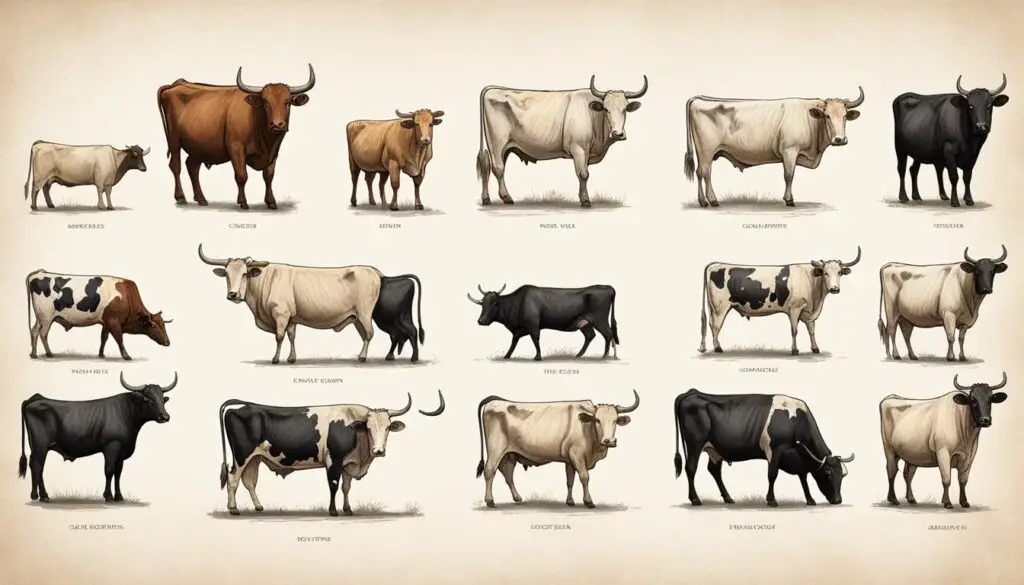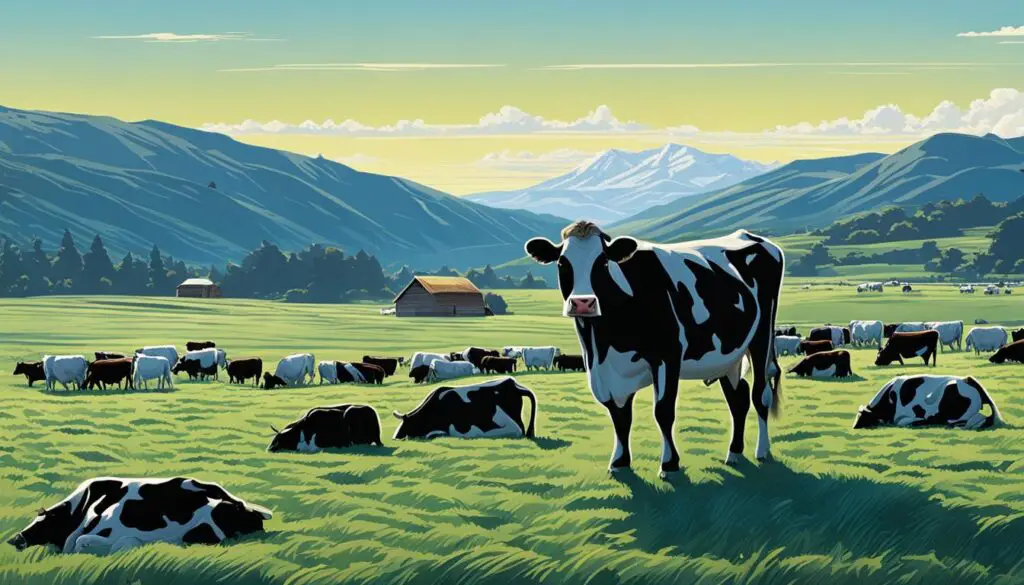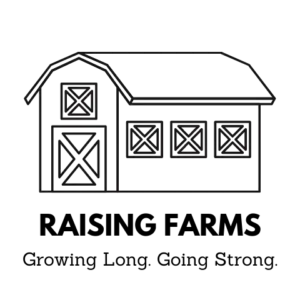Cows have been a part of human existence for centuries, providing milk, meat, and labor in agriculture, among other things. But have you ever wondered where cows originally come from? In this section, we will take a journey through time and uncover the origins of cows, tracing their history from the beginning of civilization.
Key Takeaways
- Cows have a long history dating back to the beginning of civilization.
- The ancient ancestors of cows evolved over time to become the animals we know today.
- The domestication of cows has had a significant impact on human societies.
- Ancient cow breeds and their characteristics have contributed to the diversity of cows throughout history.
- Cattle migration has played a vital role in the globalization of cows.
Cattle Evolution: An Ancient Story
Have you ever wondered about the fascinating journey of cattle evolution and how cows came to be the animals that we know today? In this section, we will explore the ancient history of cattle evolution and trace the origins of cows back to their ancestors.
The story of cattle evolution began millions of years ago when their ancestors roamed the earth. These ancestors were known as bovines, a family of mammals that includes bison, buffalo, and muskoxen. Over time, these bovines evolved and branched off into different subfamilies, one of which includes cows.
One of the most notable ancestors of cows is the aurochs, an ancient species of wild cattle that existed thousands of years ago in Europe and Asia. Aurochs were known for their large size and muscular build and were hunted by early humans.
As humans continued to domesticate animals for food and labor, cows became one of their chosen species. Through selective breeding, early humans developed different breeds of cows, each with distinctive characteristics.
Today, cows are recognized as one of the most important domesticated animals in the world. They provide us with milk, meat, and other dairy products, while also serving as working animals on farms and in other industries.
The Domestication of Cows: A Close Relationship
The domestication of cows is a process that has taken place over thousands of years. Humans have been close to these animals, using them for agriculture, transport, and food. Different cow species have been domesticated, including Bos taurus and Bos indicus, each with unique characteristics and purposes.
The domestication process of cows required taming and controlling wild bulls. The first domesticated cows were likely taught to follow humans and eat the vegetation around human settlements. Through selective breeding, humans enhanced specific traits in cows, leading to changes in their physical and behavioral characteristics. Over time, cows became more manageable and docile, allowing for a stronger bond between them and humans.
The domestication of cows had a profound impact on human society, leading to the growth of agriculture and the development of civilizations. With cows providing milk, meat, and leather, they became integral to human survival and economy. This close relationship between cows and humans continues to this day, with cows still being an essential part of many cultures and societies.
Ancient Cow Breeds: Tracing the Roots
Throughout history, cows have evolved, and different ancient cow breeds formed, each with its unique characteristics.
One of the ancient cow breeds is the Holstein, originally from the Netherlands. This breed is known for being the highest milk producer worldwide, with its black and white spots being a distinct feature.
Another ancient cow breed that we will explore is the Jersey. This breed originated from the Isle of Jersey, an island in the English Channel. These cows are usually smaller than other breeds, and their milk is high in butterfat content, making it ideal for cheese production.
Then, Galloway cattle originated from the Galloway region of Scotland. This ancient cow breed is known for powerful draught power and ability to grow quickly, to become an excellent meat-producing breed.
Finally, the Ancient White Park cow breed emerged from England and Ireland and is one of the oldest and rare cow breeds. They have distinctive large white horns, long silky hair, and their meat is tender and has a unique taste, making it one of the best-quality meats in the world.

Sources
- Farmers Weekly
- Cattle Today
- British White Cattle Society
Cattle Migration: Exploring New Horizons
Cattle migration has been a significant part of the adaptation process for cows throughout history. As the earth’s climate changed, cows followed vegetation patterns and adapted to new environments. Despite being domesticated animals today, cattle migration is still observable in some parts of the world where cows are raised.
For example, in the United States, seasonal cattle migrations are still common where ranchers move their cows from one pasture to another depending on the availability of vegetation and water sources. Similarly, in Australia, cattle stations are spread out across thousands of acres, and cowboys still move cattle on horseback.
Cattle migration has also influenced the spread of cows across the globe. For instance, cows were introduced to the Americas during the Columbian Exchange when Spanish explorers brought them from Europe. In the 19th century, cattle drives from Texas to end markets in the Midwest, and railway expansion facilitated the rapid spread of cows across the United States.
Overall, cattle migration has played a crucial role in the evolution and spread of cows throughout history. Understanding this process can offer valuable insights into the relationship between cows and their environment, and how humans have shaped the adaptation process of these animals.
Modern Cows: From Ancient Roots to Present-Day
Modern cows have a rich history that dates back thousands of years. Throughout history, cows have been selectively bred for their unique characteristics and adaptations to different environments. Today, there are numerous cow species, each with its own distinctive traits and qualities.
One of the most common cow species today is Bos Taurus, also known as the European breeds. These cows were domesticated in Europe around 6,000 years ago and were primarily bred for their meat and milk. Some of the most popular Bos Taurus breeds include the Holstein, Jersey, and Guernsey.
Another popular cow species is Bos Indicus, also known as the zebu breeds. These cows were domesticated around 8,000 years ago in the Indian subcontinent and were primarily bred for their ability to adapt to hot and dry environments. Some of the most popular Bos Indicus breeds include the Brahman, Nellore, and Gir.
Over time, cows have been selectively bred for specific traits, such as milk production, meat quality, and adaptability to various environments. This has resulted in the development of numerous cow breeds, each with a unique history and set of characteristics.

“Cows have been crucial to human society for thousands of years, providing milk, meat, and transportation. The diverse range of cow species we have today is a testament to the long, fascinating history of these animals.”
Conclusion
Throughout history, cows have played a significant role in human society, providing us with milk, meat, and companionship. Understanding the origin and evolution of cows is essential to appreciate the significance of this animal in our lives.
From the ancient domestication of cows to the current modern breeds, we have seen how cows have evolved over time and adapted to different environments. The migration patterns of cows across different regions and continents give insight into how they have contributed to the diversity of cattle worldwide.
As we continue to depend on cows for our livelihood, it is crucial to appreciate the historic roots of these animals, and the significance they hold in our lives today.
In conclusion, the origin of cows dates back to ancient times, and their evolution throughout history has been remarkable. With their close relationships to humans and their contribution to society, cows continue to be an essential animal in our lives today.
FAQ
Where are cows originally from?
Cows are believed to have originated from the region of South Asia, particularly the area now known as Pakistan and India. The wild ancestor of domesticated cows, known as the auroch, roamed these areas thousands of years ago.
What is the history of cows?
Cows have a rich history that dates back thousands of years. They have been an essential part of human civilization, providing sustenance in the form of meat, milk, and hides. Cows have also played significant roles in cultural and religious practices across different societies.
How did cows evolve over time?
Cattle evolution traces back to the auroch, a wild species that is the ancestor of domesticated cows. Over time, through selective breeding and natural adaptation, cows have evolved to have varying characteristics depending on their specific breed.
How were cows domesticated?
The process of cow domestication involved early humans selectively breeding wild aurochs to create domesticated cows with desired traits. This process took thousands of years and led to the development of different cow species that we know today.
What are some ancient cow breeds?
There are several ancient cow breeds that have been preserved throughout history. Examples include the Zebu, a hump-backed breed from South Asia, and the Ankole-Watusi, known for their distinctive horns and originated in Africa.
How did cows migrate across different regions?
Cows have historically migrated across different regions as humans moved and expanded their settlements. This migration has been facilitated by humans for various reasons, including the search for fertile grazing lands and trade routes.
What are the different cow species today?
Today, there are various cow species that have evolved from ancient roots. Some common cow species include Holstein, Angus, Jersey, and Brahman, each with distinct characteristics and purposes.

